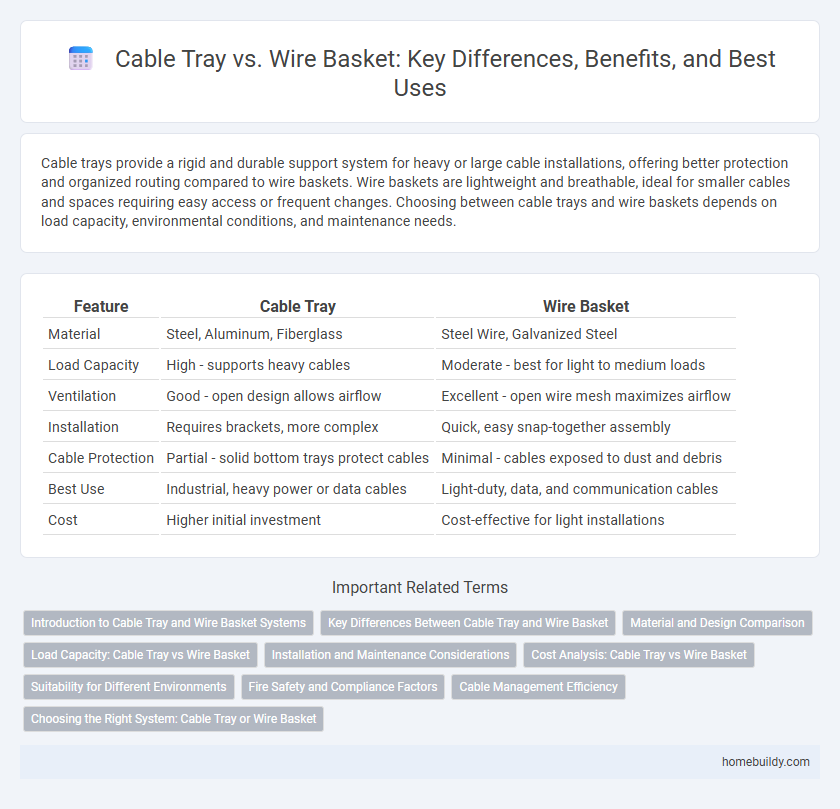Cable trays provide a rigid and durable support system for heavy or large cable installations, offering better protection and organized routing compared to wire baskets. Wire baskets are lightweight and breathable, ideal for smaller cables and spaces requiring easy access or frequent changes. Choosing between cable trays and wire baskets depends on load capacity, environmental conditions, and maintenance needs.
Table of Comparison
| Feature | Cable Tray | Wire Basket |
|---|---|---|
| Material | Steel, Aluminum, Fiberglass | Steel Wire, Galvanized Steel |
| Load Capacity | High - supports heavy cables | Moderate - best for light to medium loads |
| Ventilation | Good - open design allows airflow | Excellent - open wire mesh maximizes airflow |
| Installation | Requires brackets, more complex | Quick, easy snap-together assembly |
| Cable Protection | Partial - solid bottom trays protect cables | Minimal - cables exposed to dust and debris |
| Best Use | Industrial, heavy power or data cables | Light-duty, data, and communication cables |
| Cost | Higher initial investment | Cost-effective for light installations |
Introduction to Cable Tray and Wire Basket Systems
Cable trays provide structured support for electrical cables, offering organized pathways and enhanced protection in industrial and commercial installations. Wire baskets feature an open-grid design that promotes ventilation and easy cable management while reducing material costs. Both cable tray and wire basket systems facilitate efficient cable routing, but cable trays offer increased load capacity and durability suited for heavier or more complex installations.
Key Differences Between Cable Tray and Wire Basket
Cable trays are rigid, metal support systems designed for heavy-duty cable management, providing structured routing for electrical wiring in industrial and commercial settings. Wire baskets, made from a mesh of galvanized or stainless steel wires, offer flexible, ventilated cable organization ideal for low-voltage and data cables. The key differences include load capacity, installation complexity, and ventilation, where cable trays handle heavier loads with solid sides, while wire baskets facilitate airflow and easier access for cable changes.
Material and Design Comparison
Cable trays are typically constructed from materials like steel, aluminum, or fiberglass, offering superior strength and corrosion resistance compared to wire baskets, which are often made from galvanized steel or stainless steel. Cable trays feature a solid or slotted bottom design that provides enhanced protection for cables and better load-bearing capacity, whereas wire baskets have an open, grid-like structure that allows for improved ventilation and easier cable access. The choice between cable trays and wire baskets depends on environmental factors, weight requirements, and the need for cable protection versus flexibility in cable management.
Load Capacity: Cable Tray vs Wire Basket
Cable trays typically offer higher load capacity compared to wire baskets, making them suitable for heavy-duty cable management in industrial and commercial applications. Wire baskets are designed for lighter cable loads and provide greater ventilation but may not support as much weight as cable trays. The structural design and material thickness of cable trays contribute significantly to their enhanced load-bearing capabilities over wire baskets.
Installation and Maintenance Considerations
Cable trays offer faster installation with their rigid structure and fixed mounting points, simplifying cable routing and reducing labor time compared to wire baskets. Maintenance is easier for cable trays due to their open design, which allows straightforward cable inspection, cleaning, and replacement without disturbing the entire system. Wire baskets provide more flexibility for adding or removing cables but require more frequent adjustments and detailed cable management during maintenance.
Cost Analysis: Cable Tray vs Wire Basket
Cable trays generally offer a higher upfront cost compared to wire baskets due to their robust materials and larger size, but provide long-term savings through enhanced durability and easier maintenance. Wire baskets are more economical initially, ideal for lightweight cabling and smaller installations, yet may incur higher replacement and support costs over time due to limited load capacity and less protection. Selecting between cable trays and wire baskets requires evaluating total cost of ownership, factoring installation expenses, lifespan, maintenance needs, and specific application requirements.
Suitability for Different Environments
Cable trays offer superior protection against physical damage and environmental factors, making them ideal for industrial and outdoor settings where durability is critical. Wire baskets, with their open design, provide excellent ventilation and ease of access, suited for data centers and indoor applications requiring frequent cable changes. Selecting between cable trays and wire baskets depends on the specific environmental conditions and maintenance needs of the installation site.
Fire Safety and Compliance Factors
Cable trays offer superior fire safety compared to wire baskets due to their solid or ventilated steel construction, which minimizes the spread of flames and smoke in case of fire. Wire baskets, often made of lighter gauge steel with open mesh design, provide less resistance to fire and may allow faster ignition and flame propagation. Compliance with fire safety standards such as NFPA 70 (NEC) and IEC 61537 typically favors cable trays for their enhanced durability and ability to contain potential fire hazards in industrial and commercial installations.
Cable Management Efficiency
Cable trays provide superior cable management efficiency compared to wire baskets by offering organized routing and enhanced support for various cable types, reducing clutter and minimizing maintenance time. Their solid or ventilated design protects cables from physical damage and environmental factors, optimizing safety and longevity. Wire baskets, while flexible, often lack the robust support and structured separation that cable trays provide, leading to potential cable entanglement and increased management complexity.
Choosing the Right System: Cable Tray or Wire Basket
Choosing the right routing system depends on cable type, environment, and load capacity, where cable trays provide robust support for heavy cables and high-density installations. Wire baskets offer greater ventilation and flexibility for quick changes or additions, ideal for lightweight or low-voltage cables. Assessing factors like installation complexity, cost, and maintenance needs ensures efficient cable management and system longevity.
Cable tray vs wire basket Infographic

 homebuildy.com
homebuildy.com